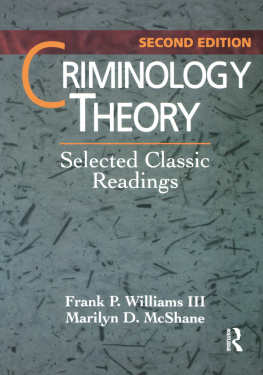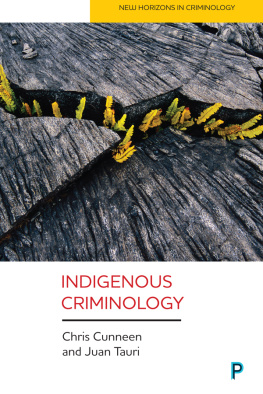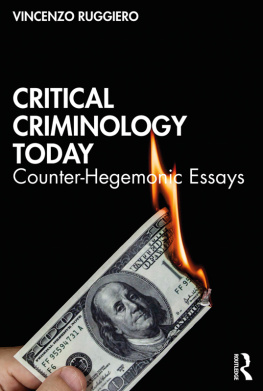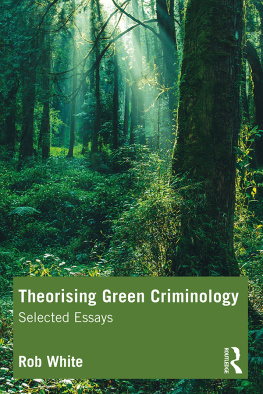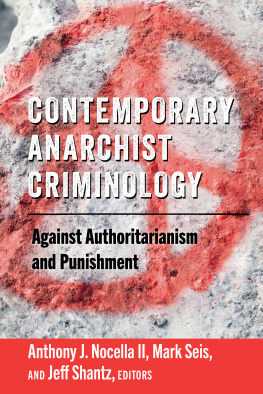IMAGINING CRIMINOLOGY
CURRENT ISSUES IN CRIMINAL JUSTICE
VOLUME 24
GARLAND REFERENCE LIBRARY OF SOCIAL SCIENCE
VOLUME 1183
First published 1999 by Garland Publishing, Inc.
2 Park Square, Milton Park, Abingdon, Oxfordshire OXI4 4RN
52 Vanderbilt Avenue, New York, NY 10017
Routledge is an imprint of the Taylor & Francis Group, an informa business
First issued in paperback 2019
Copyright 1999 by Frank P. Williarns III
All rights reserved. No part of this book may be reprinted or reproduced or utilised in any form or by any electronic, mechanical, or other means, now known or hereafter invented, including photocopying and recording, or in any information storage or retrieval system, without permission in writing from the publishers.
Notice:
Product or corporate names may be trademarks or registered trademarks, and are used only for identification and explanation without intent to infringe.
Library of Congress Cataloging-in-Publication Data
Williams, Franklin P.
Imagining criminology : an alternative paradigm / by Frank P. Williams III.
p. cm. (Garland reference library of social science ; v. 1183. Current issues in criminal justice ; v. 24)
Includes bibliographical references and index.
ISBN 0-8153-3078-2 (alk. paper)
1. CriminologyPhilosophy.I. Title.II. Series: Garland reference library of social science ; v. 1183.III. Series: Garland reference library of social science. Current issues in criminal justice ; v. 24.
HV6018.W491999
364dc21
98-42229
CIP
ISBN 13: 978-0-8153-3078-3 (hbk)
ISBN 13: 978-1-138-88032-0 (pbk)
To Marilyn McShane, my mate and best friend
As we conclude our work on the series Current Issues in Criminal Justice, I am very proud that the last contribution is Imagining Criminology. The book represents another milestone in a criminologists journey to uncover some truths about the discipline and to reflect critically on how that field has evolved. This journey, some of you may remember, began in The Sociology of Criminological Theory: Paradigm or Fad and continued in The Demise of the Criminological Imagination. To date, this latest work has already attracted considerable debate and in the tradition of C. Wright Mills, engendered somewhat heated discussion about the philosophy of criminology and the logic of its paradigms. What is perhaps most exciting about this work is that it is critical, in the true sense of critical, a term that has been abused and overused.
As editor, partner, and colleague of Frank Williams, it has been exciting to watch Imagining Criminology unfold, in a series of papers, and late night beer drinking discussions, hours on the computer staring at chaos models and sitting on the beach watching the ocean. Although the reader may not always agree about the state of the art of criminology, he or she will enjoy thinking through this book. It is an exercise in professional self-examination and it is a good workout.
Marilyn D. McShane
Most authors tend to leave readers in the dark over the assumptions they make and the way in which they come to the ideas of the work. Because I believe these are important pieces in understanding what someone has to say, this preface is oriented toward making these pieces explicit. Thus, readers will find a personal odyssey and acknowledgments in these pagesall designed to show how this book came to be and the influences that created it.
The idea for this book had its genesis over the past two decades. It seemed to me the approaches taken by various criminological theories were somewhat isolated. Each theory was seen as something different and each had its own set of champions. Rarely was anyone interested in combining and integrating theories; when it did happen, the effort seemed to interest very few. In one sense, this was surprising. The major theorists of the 1950s (Cohen, Cloward and Ohlin) were integrators, combining the Chicago School and anomie traditions. Therefore, two questions bothered me. What had we lost in the 1970s and 1980s? Why werent these separate theories seen as alternative and complementary views of reality rather than right and wrong views?
Another question should have bothered me as well: why was I asking these questions when no one else was? In retrospect, this last question was probably the easiest to answer. I came from a different background than most criminologists, being only nominally the product of a sociology education. My undergraduate education contained as much coursework in the natural sciences as the social sciences. I did brief graduate coursework in public administration and traffic engineering before deciding on criminology, and the latter choice was not then a product of actually knowing and liking criminology. Graduate education at Florida State was also a bit different than most sociological criminologists experienced. First, we were not in sociology, but were a separate school of criminology. Second, two people there were doing different sorts of things for the criminology of that period. Ron Akers was developing his social learning theory and graduate students were getting heavy doses of operant psychology. C. Ray Jeffery was duplicating the infusion of operant psychology and then lecturing on environmental design and psycho-socio-biology. The graduate students, at least the small group of which I was a part, loved to take these theoretical ideas and discuss them (and there was many a good-natured argument). Most of them, however, seemed to focus on the sociological aspects of theory. That struck me, then and now, as only looking at one part of the explanatory puzzle. Where was the psychology? The biology? The physical environment?
As a result of this feeling, I probably got along with, and spent more time with, C. Ray Jeffery than the rest of my graduate cohort. Meanwhile, Ron Akers, who became my mentor, was encouraging students to investigate all manner of theoretical concepts. One of the things he said that stuck in my mind was that he did not believe that we should follow in his footsteps and become social learning theorists. But for that comment, I probably would have done just that. Instead, I made a concerted effort to do other things.
Another major influence on this book was my reading of Thomas Kuhns The Structure of Scientific Revolutions. It seemed to me that his philosophical history of the natural sciences was right-on. Further, my natural science background led me to believe that most sociologists were reading too much into Kuhns work. His paradigms were not the wholesale world assumptions they saw. He was talking about the way in which small groups of highly specialized scientists came to an issue with the same problem-solving approach. Of course, it made sense that sociologists saw the meta-picture every time they talked about paradigms. Thus, I originally argued against the presence of paradigms in criminology. In the strict Kuhnian sense I still do, but now at least the overpowering presence of quantitative methodology leads me to believe in an overarching meta-paradigm. And, in that larger sense, I came to believe that mainstream criminology (and most of the social sciences) was (and is) viewing reality from a very narrow perspective.
How could this perspective be enlarged? That is where my first readings of chaos theory came into play. Like most occasional dabblers in the literature of the natural sciences, Gleicks best-selling 1987 book on chaos was my introduction. This seemed to be a good method for enlarging perspectives of reality, but there was no appropriate way I could find to translate chaos theory in criminology (although others certainly tried: see Pepinsky, 1991; Young, 1991). Then, I ran across a copy of


